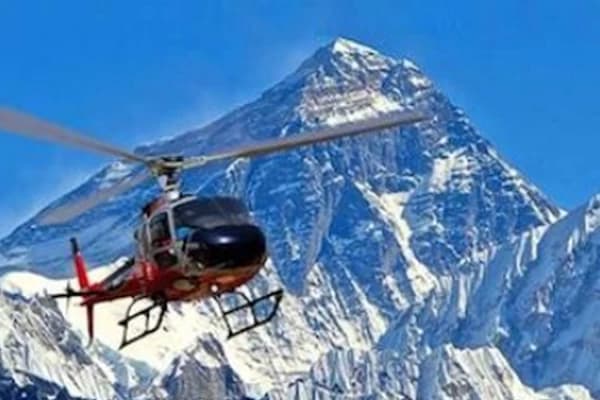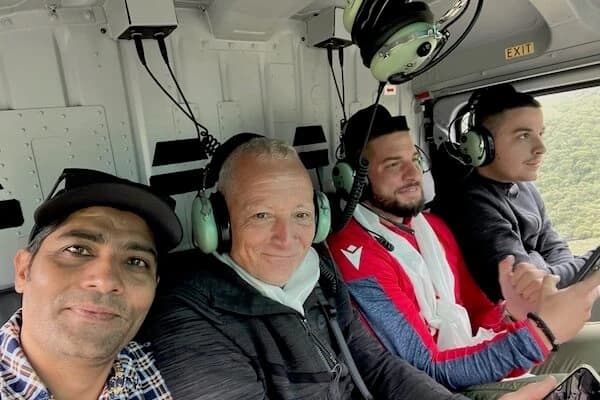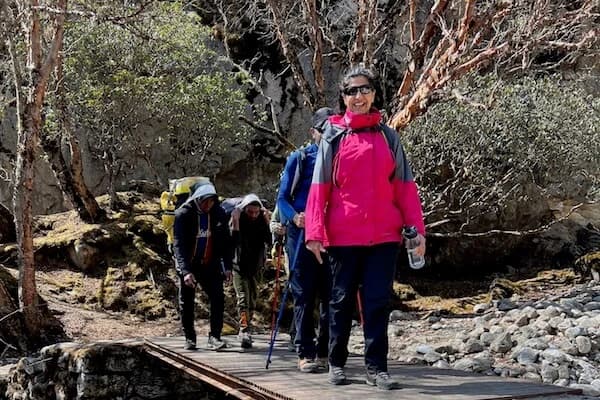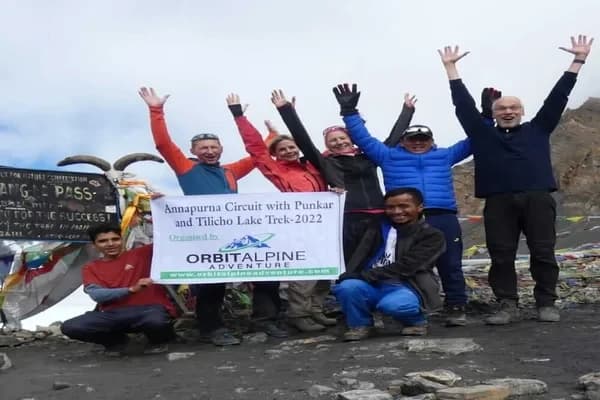You can also customize your EBC trek. But among them, the Everest base camp trek with helicopter return is a top choice. A two-way flight above one of the most beautifully decorated landscapes is already so much fun. Imagine it combined with the thrill of landing in one of the shortest runways in the lap of the Himalayas. The experience is complete with trekking in one of the best trekking trails in the world alongside Sherpa teahouses and their beautiful monasteries. You can feel heaven on earth with the stunning alpine forests and countless suspension bridges beautifully decorated with prayer flags, floras, faunas, wildflowers, and wildlife.
So, Like all the trekking enthusiasts or nature lovers in the world, you might also have Everest on your bucket list. Given the natural vistas, culture, and mountain peaks, it won’t surprise us if you have it on top of your bucket list too. But you might be bound by your less trekking experience, physicality, or tight work schedule. Or you are just not sure you are capable of doing this trek. For a traditional EBC trekking, this question would be a valid one. But with a Luxury Everest Base Camp Trek with a helicopter return, you can easily complete this trek. This trek is specially customized for those with limited physical capacity or timeframe or who just don’t want to go hard trekking.
This guide will cover all the aspects of this trek, from planning, preparation, and execution to ensuring you get all the information needed for a successful EBC trekking with helicopter return. So, let’s dive directly into it.
Planning Your Everest Base Camp Trek with Helicopter Return
As easy as this trek might sound, it can not always go as you expect. Like all the other activities, proper research and the correct information will play a vital role in easing it.

Best season for Everest Base Camp Trek?
Trekking around the Everest region is possible in all the seasons. Some seasons offer you clear skies and pleasant weather to trek. At the same time, others offer you tranquil trekking trails and better photography opportunities. There are cons and pros to all the seasons.
But, the best seasons for an EBC trek with helicopter return are Spring (March-May) and Autumn(September-November). But don't just believe our words until you get the complete information.
During Spring, the trail will be covered with colorful blooming Rhododendrons and other wildflowers. The temperature fluctuates between (10-15)℃, making it ideal for trekking. During this time of the year, the sky remains clear, providing a clear view of the surrounding scenery.
Likewise, Autumn is another rewarding season for trekking and flying around the Khumbu region. This season, right after the monsoon, is the combination of green vegetation with a clear view of the surrounding stunning views. The temperature stays neither cold nor hot, which provides a pleasant trekking experience.
Though these seasons are best for witnessing the surrounding views and trekking, they also have some unavoidable cons. These are the peak times for trekking and mountaineering in the Everest region; the trails, teahouses, and viewpoints are the busiest. However, that will flourish the business of teahouses enabling them to provide extended services too. Getting teahouses and flight tickets can be challenging during these seasons. You can always pre-book the teahouses and flights to enjoy the trek to its fullest with peace of mind.
Off seasons possibilities
Winter and Monsoon are not ideal seasons to fly or trek in this region. The situation can get harsh if you are a beginner with little to no trekking experience.
But if you are adventurous and want a peaceful trekking experience, these seasons can be your choice. There will be fewer trekkers on the trails, and you will have all the viewpoints.
The summer monsoon is when the entire valley wears the lush, green blankets, providing a perfect setting for photography. But trekking in continuous rain on slippery trails and risk of landslides this season is generally avoided for trekking. But for those who don’t mind the rain, this can be a unique time for EBC trekking. Likewise, in winter, the temperature can be freezing and snowfalls make it even harder for trekking.
Permits You need in this EBC trek with helicopter return
There are always some permits you need while trekking in Nepal. It's because you enter the area protected by either governments, national parks, or locals.
Like all the trekking in Nepal, EBC trekking also demands some permits, and they are:
- TIMS (Trekkers Information Management System) card,
- Sagarmatha National Park Entry Permit,
- Khumbu Pasang Lhamu Rural Municipality Permit
All these permits are required to ensure the safety and management of trekkers in this region. TIMS card is compulsory because, based on the information on the card, the authorities keep track of trekkers for safety reasons. Sagarmatha National Park Permit card and Khumbu Pasang Lhamu Rural Municipality Permit are required to enter the National Park and local regions.
How to get those permits?
You can get these permits through your tour operator of offices in Kathmandu or Monjo. If you book this trek with a tour operator, they will get these permits for you, simplifying the process. If not, you can get it from the Tourism Board office in Kathmandu or the Permit office in Monjo.
Things to consider while choosing a tour Operator
You can always do this trek with the information in this blog or do some research here and there. But, there are hundreds of tour operators that can seamlessly ease your trekking experience. Not only that, they act as your family in Nepal and take full responsibility for the safety and success of the trek. But choosing a reputable and experienced tour operator is equally important. A good operator will ensure all the aspects of the trek are well-managed, from securing your permits to managing experienced guides and arranging accommodations.
So, while choosing a trekking agency for your Everest trek, consider evaluating;
- Experience and Expertise: You should look for operators who have successfully conducted the Everest Base Camp trek many times. They have experienced trekking guides and good connections with the locals of the EBC region.
- Safety measures: You must ensure your trekking operator follows the safety protocols and has a strong safety record. They should be able to provide quick medical and evacuation facilities if needed.
- Inclusions and Exclusions: Before choosing your tour operator, be aware of the inclusions and exclusions in the package so there are no hidden edges with the pricing.
- Client reviews and Testimonials: Client reviews and testimonials are excellent sources of their quality of work and reputation. Search for genuine reviews; if you can ask past clients, that would be the best.
- Certifications and Affiliations: Trekking agencies affiliated with recognized trekking associations with the necessary certifications should be your only choice. These certifications prove the trekking operator is up to industry standards and best practices.
Cost of Everest Base Camp Trek with Helicopter Return
This trek typically ranges from $3000 - $5000 per person. But this price range doesn’t apply in all cases. It can easily vary based on the tour operator, the level of service you want, and the trekking season.
But to give you a basic idea of the inclusions and exclusions you can expect from a typical trekking package from most tour operators, we have prepared a list;
Typically Included
- Domestic flights (Kathmandu to Lukla and return),
- Accommodation in lodges/teahouses,
- All meals (Breakfast, Lunch, Dinner) during the trek,
- Permits and entry fees,
- Experienced guide and porter services,
- Helicopter return from Kala Patthar or Gorak Shep to Kathmandu.
Typically Excluded
- International flights,
- Travel Insurance,
- Personal expenses (snacks, drinks, souvenirs),
- Tips for guides and porters.
Training and Preparation for the EBC trek
Staying healthy and fit is always beneficial. But it's more crucial than ever when walking out of your comfort zone. EBC trekking is not something you will do every day;d while doing it, your physicality or any other distractions shouldn't affect your experience. Proper training and preparation will make all the difference while trekking at a high altitude. Not only that, it will help in avoiding any risk of altitude sickness too.
Some tips to prepare yourself for Everest Base Camp Heli Trek
- Cardio Exercise: Running, cycling, and swimming are good cardio practices to build stamina and improve your cardio fitness,
- Strength Training: Focus on maintaining your legs and core muscles. Strong legs help you in the ascent and descent on steep trails, while a strong core provides stability,
- Hiking Practices: Simulating a trekking environment and staying prepared is a proven training method. You can gradually increase the load and hiking difficulty to prepare better for the trek,
- Altitude Acclimatization: If possible, expose yourself to the high altitude or use the altitude simulation mask to adapt your body before the trek.
Essential Gears and Equipment
Packing while trekking is tricky. If you are trekking on your own, packing right is crucial to make or break your trekking experience. Your luggage should be carried even if you are trekking with your tour operator. It won't make you feel right if someone carries your unnecessary weight at a high altitude.
Clothing:
- Thermal wear,
- Down Jacket,
- Fleece,
- Waterproof Jackets and Pants,
- Trekking Shirt and Pants,
- Gloves,
- Beanie
Footwear:
- Waterproof and comfortable trekking boots,
- Comfortable Trekking socks,
- Sandals for the Evening.
Accessories:
- Sunglasses,
- Sunscreen,
- Trekking Poles,
- Lip balm,
- Headlight,
- Water Bottles.
Backpack:
- A daypack for personal items that should have enough space for carrying essentials like water, snacks, and extra layers,
- A larger backpack for the porter to carry all your other stuff.
[NOTE: You can rent some stuff like sleeping bags and down jackets in Thamel if you don’t trek frequently or want to save some budget. However, buying your stuff is suitable for good fit and hygiene]
Health and Medical Considerations
A thorough health checkup before trekking will secure your health and give you the needed confidence. If you have a particular medical condition, consult your doctor first. You should carry other essential medications for altitude sickness, headache, and digestive issues.
Basic Medications
- Altitude sickness medication,
- Pain relievers (ibuprofen, paracetamol),
- Anti-diarrheal tablets,
- Personal prescriptions,
- Basic first aid supplies (band-aids, antiseptic wipes, blister care)
Itinerary of Everest Base Camp Trekking with Helicopter Return
Day 01: Fly to Lukla (2,860m/9,383ft) and Trek to Phakding (2,610m/8,563ft) -4 Hours
The first day of this Everest base camp luxury trek begins with the scenic flight from Kathmandu to Lukla over the dramatic landscape of Nepal and sky-high mountains. The journey immediately gets exciting as you will glimpse the bird-eye view of the regions you will spend your next nine days. On a dramatic landing at Namche, you will meet your trekking team. On the same day, you will trek to Phakding. The trails descend through small villages and forests, leading you to Phakding. Overnight stay at Phakding.
Day 02: Trek to Namche Bazaar (3,440m/10,958ft) -6 Hours
On this day, we will trek following the Dudh Koshi River, passing through numerous suspension bridges decorated with prayer flags and the forests of pines and rhododendrons. A challenging ascent of about 6 hours leads you to the Namche Bazaar, a bustling Sherpa town and the central trading hub of the entire Khumbu region. Overnight stay at Namche Bazaar.
Day 03: Acclimatization Day at Namche Bazaar
This is an acclimatization day at Namche Bazaar with countless activities and the most essential thing to acclimatize the body for the upcoming days. Today, you will visit Everest View Point Hotel for an up-close view of Mt. Everest and other peaks. You can hike to the Sherpa Museum, which will add great cultural value to your trek and provide first-hand experience of Sherpa culture and traditions. Overnight stay at Namche Bazaar.
Day 04: Trek to Tengboche (3,860m/12,664ft) -5 Hours
Today, you will trek through the beautiful Rhododendron forests alongside the Dudhkoshi River to reach Tengboche. You will enjoy the trek playing hide and seek with stunning views of mountains like Everest, Lhotse, and Ama Dablam. On reaching Tengboche, you will visit the Tengboche monastery, one of this region's largest and most famous monasteries. Overnight stay at Tengboche.
Day 05: Trek to Dingboche (4,410m/14,469ft) – 5 Hours
Today, you will trek, passing through alpine landscapes and small villages like Imja Valley to reach Dingboche. The trail offers an outstanding view of Nepal's considerably most beautiful mountain i.e., Ama Dablam. After about five hours of trekking, you will reach Dingboche. Dingboche is a picturesque village surrounded by Barley, Potatoes, and Buckwheat fields. Overnight stay at Dingboche.
Day 06: Acclimatization Day
You will spend another day at Dingboche for acclimatization because your next destination is almost 5000m. Today, you can hike to Nagarjun Hill or Chhukung Valley for acclimatization and a spectacular view of Makalu, Lhotse, and Cho Oyu. Overnight stay at Dingboche.
Day 07: Trek to Lobuche (4,910m/16,109ft) -5 Hours
Today, you will trek through the beautiful Khumbu valley, passing the memorials dedicated to climbers who lost their lives in Everest. As you gain altitude, the trail becomes more rugged, the air thinner, the landscape more barren, and the peaks seem closer. Overnight stay at Lobuche.
Day 08: Trek to Gorak Shep (5,140m/16,864ft) and Hike to Everest Base Camp (5,364m/17,598ft) -8 Hours
This day is comparatively more challenging than others as you will trek to Gorakshep, the last settlement before Everest Base Camp. After a short break at Gorakshep, you will continue towards EBC. Standing at the feet of the world’s highest mountain, you can enjoy awe-inspiring Khumbu icefalls and towering peaks. Overnight stay at Gorakshep.
Day 09: Hike to Kala Patthar (5,550m/18,209ft) and Helicopter Flight Back to Kathmandu – 60 Minutes
Today, you will wake up early and hike to the vintage viewpoint of Kala Patthar for one of the best sunrise views of Everest, Lhotse, and Ama Dablam. Then, you will descend to Gorakshep and board the helicopter for a scenic flight back to Kathmandu.
Some of the Available Treks are: Everest Base Camp Helicopter Tour, Everest Base Camp Luxury Trek, Everest Base Camp Trek with Helicopter Return and Everest Three High Passes Trek

Additional Things to Consider
Travel Insurance
Ensure you have comprehensive travel insurance covering all medical emergencies, trip cancellations, and evacuations. It will give you peace of mind and financial protection in unforeseen circumstances.
Sustainable Practice
This natural beauty is complex to conserve, and it's our responsibility to pass these resources to future generations in good condition. So you should respect the environment by following the Leave No Trace Principle:
- Pack out all trash,
- Minimize campfire impact,
- Respect wildlife and local cultures,
- Stay on marked trails.
Cultural Sensitivity
This trek is to enjoy the Everest region's unmatched beauty and gain first-hand experience of Sherpa culture. Understanding and respecting local culture is essential for adding depth to your trekking experience and encouraging positive interactions with locals.
- Be mindful of local customs, cultures, and traditions,
- Dress modestly,
- Ask for permission before taking pictures of local people,
- Learn basic Nepali phrases to show respect.
Conclusion
The Everest Base Camp Trek with Helicopter Return offers an extraordinary adventure combining the trekking challenge with the luxury of a helicopter tour. Whether short on time or seeking an adventurous yet luxurious experience, this trek will provide you with the best of both worlds. With careful planning and preparation, you will experience the trekking of a lifetime.
With the beauty of the Khumbu region, sky-high mountains, sherpa culture, and the thrill of landing at the lap of Everest, this trek is a perfect combination of natural and cultural aspects with luxury.
From the excitement of seeing the snow-capped mountains of Nepal for the first time to standing right in front of the world's highest mountains, every moment of this trek is filled with excitement and wonder.
Let's join in this journey together and experience the beauty of the Everest region like never before.
Some of the alternative treks are the Everest Base Camp Helicopter Tour, Everest Three High Passes Trek, Everest Base Camp Short Trek, and Everest Base Camp Trek.








